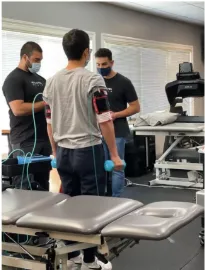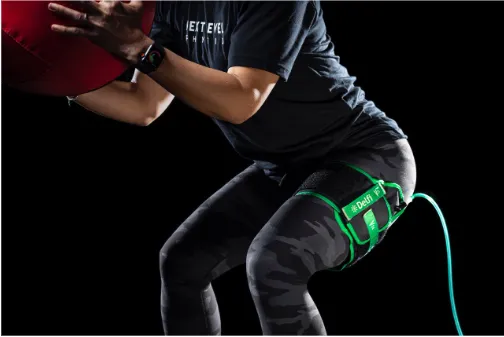Can’t Run, But Losing Your Running Fitness?
5 MINUTES READ
Why Runners Are Turning to BFR to Maintain VO2 Max When Injured Or Break Through Running Plateaus
VO2 Max: More Than Running – Exploring New Ways to Boost Fitness
Now that the marathon season is over and the off-season, well-earned R&R begins, remember that VO2 max drops in a matter of weeks, which is one reason why it’s hard to get back on the wagon after the New Year for many runners.
Many of the runners we work with focus on our strength training for runners program during the winter to build the right foundation before their next base build. We all know the value of strength training in runners and how it enhances longevity.
And, when it comes to further optimizing fitness and longevity, VO2 max—a measure of how well your body uses oxygen during exercise—stands out as a critical metric.
A higher VO2 max translates to better endurance, improved cardiovascular health, and even increased lifespan.
For runners, maintaining a high VO2 max is non-negotiable. Running is the classic method to train it, but what happens when injury, surgery, or tapering takes running off the table?

The great news is that there are effective alternatives, including the innovative use of Blood Flow Restriction (BFR) Therapy. Let’s explore how you can boost VO2 max, even when running isn’t an option.
What is VO2 Max, and Why is it Vital?
VO2 max reflects the synergy between your heart, lungs, and muscles in delivering and using oxygen. It’s impacted by two main factors:
Cardiac Output: The amount of blood your heart pumps per minute.
Oxygen Extraction (a-vO2 Difference): How efficiently your muscles pull oxygen from the blood.
While part of VO2 max is genetic, the other half is highly trainable. This makes it a flexible and rewarding metric for athletes to improve.
Beyond Running: Effective VO2 Max Alternatives
Running may be the default exercise for improving VO2 max, but these alternatives work wonders—whether you’re cross-training, recovering, or just looking to mix things up. This is particularly important for cross-training or if you’re injured and need another way to keep your VO2 max up.
Cycling
Cycling recruits large muscle groups and allows you to adjust intensity. It’s a joint-friendly option for building aerobic capacity.
Rowing
Rowing offers a full-body workout, engaging both the upper and lower body while boosting oxygen utilization.
Swimming
Swimming is perfect for cardiovascular training with minimal joint strain, especially during recovery phases.
BFR Training

This groundbreaking technique is a game-changer. Blood Flow Restriction (BFR) Training creates a controlled environment where oxygen is limited to the working muscles.
BFR amplifies the training effect, even at lower intensities. It’s particularly effective for VO2 max improvement without the wear and tear of high-impact activities.
How BFR Training Works to Boost VO2 Max
BFR uses cuffs to partially restrict blood flow during low-intensity exercise, mimicking the effects of high-intensity training. I know, it may sound counterintuitive!
Imagine being able to walk around with cuffs on your legs for 15-20 minutes, while getting the full benefit of running for 45 minutes…
Do you see how this could be an amazing adjunct on days where you need more recovery or can’t run because of that nagging knee or plantar fascia pain??
The method not only enhances cardiovascular fitness but also promotes muscle growth and efficiency. Here's a deeper dive into its optimal application for runners:
Frequency: 1-3 times per week for more than 3 weeks, or 1-2 times per day for up to 3 weeks.
Duration: 5-20 minutes per session.
Intensity: ≤50% VO2 max.
Pressure: 40-80% arterial occlusion pressure with BFR cuffs, or a 6-7 out of 10 tightness for practical use.
Protocol: Cycling or walking with BFR applied.
A key study highlighted a low-intensity BFR protocol that produced impressive results:
15 minutes of cycling at 40% VO2 max with BFR.
3 times per week.
Over 8 weeks.
This protocol resulted in cardiovascular benefits comparable to 45 minutes of traditional cycling at the same intensity. Additionally, participants saw significant gains in thigh muscle volume and VO2 max compared to a control group.
It’s important to note that BFR training should supplement, not replace, traditional high-intensity workouts.
Training Intensity Distribution for VO2 Max
In addition to BFR, balancing training intensity across zones is essential for comprehensive improvement. Here’s how to structure your training:
Low Intensity (60-80% HR max): 70% of training.
Ideal for building efficiency and recovery.
Conversational pace with nasal breathing.
Moderate Intensity (80-90% HR max): 25% of training.
Focuses on endurance and aerobic development.
High Intensity (>90% HR max): 5% of training.
Short bursts push your cardiovascular limits, driving VO2 max improvements.
Why Next Level Physio Uses BFR
At Next Level Physio in Cary, we leverage BFR as part of our MEI Method, a three-phase system designed to help athletes recover, excel, and exceed their performance goals. In the Excel Phase, BFR plays a critical role in rebuilding strength and endurance. Its low-impact nature makes it ideal for athletes who need to stay active during recovery while still achieving significant performance gains.
Safety and Effectiveness
Proper BFR application is key to success. Using the right cuff size and pressure ensures safety and maximizes effectiveness. Consulting with a professional—like those at Next Level Physio—helps you start a program tailored to your needs and goals.
Final Thoughts
VO2 max isn’t just about running; it’s about how you approach fitness holistically. Whether you're sidelined by injury or looking for new ways to enhance performance, incorporating BFR into your training regimen can help you achieve measurable gains without added strain.
Curious about how we help many runners and hybrid athletes back to running in less than a month?
Click here to schedule a free runners assessment with us today to discover how BFR and our MEI Method can take your fitness to the next level. Whether you're aiming to recover or improve, we’ve got you covered!
Post Address and Mail
Email: info@nlphysio.com
Address
1055 Darrington Drive
Cary, NC 27513
Get In Touch
Hours
Mon - Fri: 9:00 am- 6:00 pm
Sat: By Appointment (8:00 am - 12:00 nn)
Sun: Closed
Phone Number:
919-650-4633
Office: 1055 Darrington Drive
Cary, NC 27513
Call 919-650-4633
Email: info@nlphysio.com
Site: www.nlphysio.com

